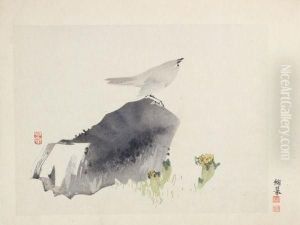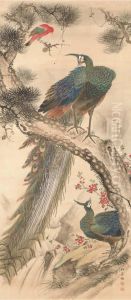Taki Katei Paintings
Taki Katei was a significant Japanese artist, born in 1830 in Edo (present-day Tokyo), Japan, and passing away in 1901. He emerged as a prominent figure in the Meiji period, a time of rapid modernization and Westernization in Japan, yet his work deeply rooted in the traditional Japanese painting style known as Nihonga. His life and career spanned a fascinating period in Japanese history, where the country transitioned from the isolationist policies of the Tokugawa shogunate to the modernizing era of the Meiji Restoration.
Katei's artistic journey began at a young age, showing early promise and dedication to mastering the art of traditional Japanese painting. He studied under various masters, including the renowned artist Suzuki Hyakunen, which greatly influenced his style and technique. His work is characterized by its meticulous detail, vibrant colors, and adherence to the themes and techniques of the Edo period, despite the changing times. Katei specialized in bird-and-flower paintings (kacho-e), a genre that highlights the beauty of nature, a subject that he portrayed with exceptional skill and sensitivity.
Throughout his career, Taki Katei achieved considerable success and recognition. He was awarded at domestic and international expositions, and his works were collected by influential figures in Japan and abroad. Notably, he was commissioned to produce works for the Imperial family, a testament to his reputation and the high esteem in which he was held. Despite his success, Katei remained deeply connected to his traditional roots, and his works reflect a deep reverence for nature and the legacy of Japanese art.
Katei's legacy extends beyond his paintings; he was also a respected teacher, imparting his knowledge and techniques to a new generation of artists. His influence helped to preserve traditional Japanese painting techniques during a period of significant cultural and artistic transformation. Today, Taki Katei is remembered as a master of Nihonga, whose work encapsulates the beauty of Japan's natural world and serves as a bridge between the country's past and its rapidly modernizing future.

